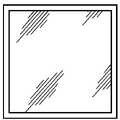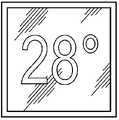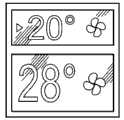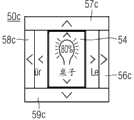CN103902199A - Distance-assisted control of display abstraction and interaction mode - Google Patents
Distance-assisted control of display abstraction and interaction modeDownload PDFInfo
- Publication number
- CN103902199A CN103902199ACN201310734042.3ACN201310734042ACN103902199ACN 103902199 ACN103902199 ACN 103902199ACN 201310734042 ACN201310734042 ACN 201310734042ACN 103902199 ACN103902199 ACN 103902199A
- Authority
- CN
- China
- Prior art keywords
- display
- information
- user
- interaction device
- matching
- Prior art date
- Legal status (The legal status is an assumption and is not a legal conclusion. Google has not performed a legal analysis and makes no representation as to the accuracy of the status listed.)
- Pending
Links
Images
Classifications
- G—PHYSICS
- G06—COMPUTING OR CALCULATING; COUNTING
- G06F—ELECTRIC DIGITAL DATA PROCESSING
- G06F3/00—Input arrangements for transferring data to be processed into a form capable of being handled by the computer; Output arrangements for transferring data from processing unit to output unit, e.g. interface arrangements
- G06F3/01—Input arrangements or combined input and output arrangements for interaction between user and computer
- G06F3/017—Gesture based interaction, e.g. based on a set of recognized hand gestures
- G—PHYSICS
- G06—COMPUTING OR CALCULATING; COUNTING
- G06F—ELECTRIC DIGITAL DATA PROCESSING
- G06F3/00—Input arrangements for transferring data to be processed into a form capable of being handled by the computer; Output arrangements for transferring data from processing unit to output unit, e.g. interface arrangements
- G06F3/01—Input arrangements or combined input and output arrangements for interaction between user and computer
- G06F3/048—Interaction techniques based on graphical user interfaces [GUI]
- G06F3/0487—Interaction techniques based on graphical user interfaces [GUI] using specific features provided by the input device, e.g. functions controlled by the rotation of a mouse with dual sensing arrangements, or of the nature of the input device, e.g. tap gestures based on pressure sensed by a digitiser
- G06F3/0488—Interaction techniques based on graphical user interfaces [GUI] using specific features provided by the input device, e.g. functions controlled by the rotation of a mouse with dual sensing arrangements, or of the nature of the input device, e.g. tap gestures based on pressure sensed by a digitiser using a touch-screen or digitiser, e.g. input of commands through traced gestures
- G—PHYSICS
- G06—COMPUTING OR CALCULATING; COUNTING
- G06F—ELECTRIC DIGITAL DATA PROCESSING
- G06F1/00—Details not covered by groups G06F3/00 - G06F13/00 and G06F21/00
- G06F1/26—Power supply means, e.g. regulation thereof
- G06F1/32—Means for saving power
- G06F1/3203—Power management, i.e. event-based initiation of a power-saving mode
- G06F1/3206—Monitoring of events, devices or parameters that trigger a change in power modality
- G06F1/3231—Monitoring the presence, absence or movement of users
- G—PHYSICS
- G06—COMPUTING OR CALCULATING; COUNTING
- G06F—ELECTRIC DIGITAL DATA PROCESSING
- G06F1/00—Details not covered by groups G06F3/00 - G06F13/00 and G06F21/00
- G06F1/26—Power supply means, e.g. regulation thereof
- G06F1/32—Means for saving power
- G06F1/3203—Power management, i.e. event-based initiation of a power-saving mode
- G06F1/3234—Power saving characterised by the action undertaken
- G06F1/325—Power saving in peripheral device
- G06F1/3265—Power saving in display device
- G—PHYSICS
- G06—COMPUTING OR CALCULATING; COUNTING
- G06F—ELECTRIC DIGITAL DATA PROCESSING
- G06F3/00—Input arrangements for transferring data to be processed into a form capable of being handled by the computer; Output arrangements for transferring data from processing unit to output unit, e.g. interface arrangements
- G06F3/01—Input arrangements or combined input and output arrangements for interaction between user and computer
- G06F3/011—Arrangements for interaction with the human body, e.g. for user immersion in virtual reality
- G—PHYSICS
- G06—COMPUTING OR CALCULATING; COUNTING
- G06F—ELECTRIC DIGITAL DATA PROCESSING
- G06F3/00—Input arrangements for transferring data to be processed into a form capable of being handled by the computer; Output arrangements for transferring data from processing unit to output unit, e.g. interface arrangements
- G06F3/01—Input arrangements or combined input and output arrangements for interaction between user and computer
- G06F3/03—Arrangements for converting the position or the displacement of a member into a coded form
- G06F3/0304—Detection arrangements using opto-electronic means
- G—PHYSICS
- G06—COMPUTING OR CALCULATING; COUNTING
- G06F—ELECTRIC DIGITAL DATA PROCESSING
- G06F3/00—Input arrangements for transferring data to be processed into a form capable of being handled by the computer; Output arrangements for transferring data from processing unit to output unit, e.g. interface arrangements
- G06F3/01—Input arrangements or combined input and output arrangements for interaction between user and computer
- G06F3/048—Interaction techniques based on graphical user interfaces [GUI]
- G06F3/0484—Interaction techniques based on graphical user interfaces [GUI] for the control of specific functions or operations, e.g. selecting or manipulating an object, an image or a displayed text element, setting a parameter value or selecting a range
- G06F3/04847—Interaction techniques to control parameter settings, e.g. interaction with sliders or dials
- Y—GENERAL TAGGING OF NEW TECHNOLOGICAL DEVELOPMENTS; GENERAL TAGGING OF CROSS-SECTIONAL TECHNOLOGIES SPANNING OVER SEVERAL SECTIONS OF THE IPC; TECHNICAL SUBJECTS COVERED BY FORMER USPC CROSS-REFERENCE ART COLLECTIONS [XRACs] AND DIGESTS
- Y02—TECHNOLOGIES OR APPLICATIONS FOR MITIGATION OR ADAPTATION AGAINST CLIMATE CHANGE
- Y02D—CLIMATE CHANGE MITIGATION TECHNOLOGIES IN INFORMATION AND COMMUNICATION TECHNOLOGIES [ICT], I.E. INFORMATION AND COMMUNICATION TECHNOLOGIES AIMING AT THE REDUCTION OF THEIR OWN ENERGY USE
- Y02D10/00—Energy efficient computing, e.g. low power processors, power management or thermal management
Landscapes
- Engineering & Computer Science (AREA)
- Theoretical Computer Science (AREA)
- General Engineering & Computer Science (AREA)
- Physics & Mathematics (AREA)
- General Physics & Mathematics (AREA)
- Human Computer Interaction (AREA)
- User Interface Of Digital Computer (AREA)
Abstract
Description
Translated fromChinese技术领域technical field
本发明涉及在交互设备上的信息显示的匹配的技术领域。The invention relates to the technical field of matching of information displays on interactive devices.
背景技术Background technique
当前的现有技术一般要求在用于控制和输出的不同显示类型之间进行手动变换。时间控制的机制也是典型的,这些机制类似于屏幕保护程序那样在定义的时间间隔之后无交互地自动变换到信息显示中。在下一次交互(鼠标移动,显示屏触及等)、即手动步骤时又变换到控制模式中。Current prior art generally requires manual switching between different display types for control and output. Time-controlled mechanisms are also typical, similar to screensavers that automatically change to the information display after a defined time interval without interaction. On the next interaction (mouse movement, display touch, etc.), ie a manual step, it changes back into control mode.
还已知简单的移动信号器,其在环境中存在被识别的人员的情况下激活一种系统。但是在此情况下并不在信息输出与控制之间加以区分,该系统只是被激活,在此一般被置于到输出模式中。在此,为了进行向控制模式的可设想的转换,再次需要手动步骤。Simple mobile signalers are also known which activate a system in the presence of a recognized person in the environment. In this case, however, no distinction is made between information output and control, the system is simply activated and generally put into output mode. Here again, manual steps are required for the conceivable switchover to the control mode.
但是与应用者关联的以下显示并无变化:该应用者是否能够从其当前的停留地点来控制该设备或在输出模式中所显示的信息是否被有意义地领会。However, there is no change in the display associated with the user: whether the user is able to control the device from his current location or whether the information displayed in the output mode is meaningfully interpreted.
同样已知由于接近而激活或停用显示器的系统。对此最为已知的例子是在移动电话中的接近传感器。当人们拿着电话靠近耳朵时,这些接近传感器关闭显示器(以及所属的接触灵敏的面)。这应当避免通过当保持在耳朵处时用身体进行接触而无意地激活控制元件。但是在此情况下这是一种在紧邻情况下纯二进制的功能(接通/关闭)并且不能扩展到其它状况。因此在两种状态中使用者都要靠近设备并且由此理论上才能控制该设备。Also known are systems for activating or deactivating displays due to proximity. The best known example of this is the proximity sensor in mobile phones. These proximity sensors switch off the display (and the associated touch-sensitive surface) when a person holds the phone close to the ear. This should avoid inadvertent activation of the control element by physical contact while held at the ear. In this case, however, this is a purely binary function (on/off) in the immediate case and cannot be extended to other cases. In both states, the user therefore has to be close to the device and can thus theoretically control the device.
用户界面(人机接口,HMI)一般由于典型的使用而得到优化。如果应当主要可以进行输入,则显示对应的控制元件。但是如果首先期望信息的显示,则几乎不存在控制元件,信息出现在前景中。User interfaces (human machine interfaces, HMIs) are generally optimized for typical use. If an input should primarily be possible, the corresponding control element is displayed. However, if the display of information is first desired, there are hardly any control elements and the information appears in the foreground.
发明内容Contents of the invention
因此本发明所基于的任务是将用户界面灵活地与使用相匹配。The invention is therefore based on the task of adapting the user interface flexibly to the use.
该任务通过在独立权利要求中描述的解决方案来解决。本发明的有利构型在其它权利要求中说明。This task is solved by the solutions described in the independent claims. Advantageous configurations of the invention are specified in the other claims.
根据第一方面,本发明涉及一种交互设备,该交互设备包括用户界面、接近传感器、逻辑模块和软件。用户界面包括输出设备。软件可以在逻辑模块上实施。该软件被构造为分析接近传感器的数据并且控制用户界面。此外接近传感器被构造为检测应用者向接近传感器的可视区域的接近。所述软件被构造为借助所识别的接近来匹配在输出设备上的信息显示,并且在应用者至接近传感器的距离减小的情况下细化该信息显示。According to a first aspect, the invention relates to an interaction device comprising a user interface, a proximity sensor, a logic module and software. The user interface includes output devices. Software can be implemented on logical modules. The software is configured to analyze the proximity sensor data and control the user interface. Furthermore, the proximity sensor is designed to detect the approach of the user to the field of view of the proximity sensor. The software is designed to adapt the information display on the output device by means of the detected proximity and to refine the information display as the distance of the user from the proximity sensor decreases.
根据另一方面,本发明涉及一种用于匹配在交互设备上的信息显示的方法。在此,通过交互设备检测应用者至交互设备的距离。然后通过交互设备自动将交互设备上的信息显示与所检测的距离相匹配。在此在应用者的距离减小的情况下自动细化该信息显示。According to another aspect, the invention relates to a method for adapting the display of information on an interaction device. Here, the distance from the user to the interactive device is detected by the interactive device. The information displayed on the interactive device is then automatically matched with the detected distance by the interactive device. In this case, the information display is automatically refined as the user's distance decreases.
附图说明Description of drawings
下面借助实施例结合附图更详细阐述本发明。在此:The invention will be explained in more detail below with the aid of exemplary embodiments in conjunction with the accompanying drawings. here:
图1示出针对楼宇基础设施的交互设备的框图;Figure 1 shows a block diagram of an interactive device for building infrastructure;
图2示出图1的交互设备连同暗线插座的视图;Fig. 2 shows a view of the interactive device of Fig. 1 together with a wall socket;
图3A-3F借助空调控制装置示出具有不同模式的显示的面板;以及Figures 3A-3F show panels with different modes of display by means of an air-conditioning control device; and
图4A-4C示出其中在侧面提供控制模式中的其它程序的面板。4A-4C show panels in which other programs in the control mode are provided on the side.
具体实施方式Detailed ways
图1和图2示出被构造为和/或被适配为控制楼宇基础设施的交互设备10。交互设备10包括用户界面14、接近传感器5、构造为处理器或计算机系统的逻辑模块12以及可以在逻辑模块12上实施的软件27。用户界面14包括接触灵敏的显示器54a作为输出设备。软件27被构造为分析接近传感器5的数据并且控制用户界面14。接近传感器5被构造为检测应用者1向接近传感器5的可视区域的接近。该软件被构造为借助所识别的接近匹配输出设备54a上的信息显示并且在应用者的距离减小的情况下细化信息显示。作为概念“接近传感器”的同义词在本申请的范围内也使用概念“接近/距离传感器”。Figures 1 and 2 show an
根据一种优选的实施方式,检测应用者1的接近包括确定交互设备10与应用者1之间的距离。According to a preferred implementation manner, detecting the approach of the user 1 includes determining the distance between the
根据另一种优选的实施方式,软件被构造为经由输入设备接收输入。由于在图1中所示的实施例中该输出设备是接触灵敏的显示器54a,因此该输出设备同时也是输入设备。在其它实施方式中,用户界面替换或附加于接触灵敏的显示器地包括构造为输入设备的机械旋钮、按钮和/或开关。According to a further preferred embodiment, the software is designed to receive input via the input device. Since the output device is a touch-
输入设备54a和输出设备在此有利地相互集成,要么在组合的设备(例如触摸面板、接触灵敏的显示屏)中要么通过位置上的彼此靠近,例如在输出设备旁或在输出设备周围的旋钮、开关等形式的物理开关元件。The
接近/距离传感器在其检测区域中连续地检测对象。为此可以采用不同的技术,例如:The proximity/distance sensor continuously detects objects in its detection area. Different techniques can be used for this, for example:
-超声波传感器;- Ultrasonic sensors;
-红外传感器;- Infrared sensor;
-热相机;- thermal camera;
-摄像机;- video camera;
-3D重构设备(参见Microsoft Kinect: http://www.xbox.com/de-DE/Kinect)。- 3D reconstruction device (see Microsoft Kinect:http://www.xbox.com/de-DE/Kinect ).
视传感器而定可以检测质量不同的传感器值。在此情况下,难点还在于人员和物体的区别。但是在此情况下可以将长时间保持静止的对象也分类为物体并加以“屏蔽”。根据另一优选的实施方式,软件27被构造为将长时间保持静止的对象分类为物体并因此不将该对象解释为应用者1。但是传感器不必一定首先识别移动,而是直到传感器与使用者/对象之间的距离达到一定程度才识别移动。Depending on the sensor, sensor values of different qualities can be detected. In this case, the difficulty also lies in the distinction between persons and objects. In this case, however, objects which remain stationary for a long time can also be classified as objects and "masked". According to a further preferred embodiment, the
为了改善所获得的传感器数据,还可以将不同的传感器相互组合。In order to improve the acquired sensor data, it is also possible to combine different sensors with one another.
根据优选的实施方式,信息显示的匹配包括显示抽象化的匹配。如果应用者移动到接近/距离传感器5的可视区域中,则首先激活输出设备54a,例如从省电模式中唤醒。在此,交互设备10以粗略的信息模式开始。在此,随着交互设备10与使用者之间的距离减小,信息显示以任意离散的级别或也无级地被细化。因此,输出显示的抽象化随着距离的减小而降低。According to a preferred embodiment, the matching of the information display includes the matching of the display abstraction. If the user moves into the field of view of the proximity/
在与交互设备10紧邻时——在此可能的是使用者1现在实际上可以与设备交互,交互设备10变换到控制模式。输出现在被优化为,使得使用者与交互设备10交互。这例如包括对控制元件的选择、操作、变换。由此信息显示的匹配包括交互模式的匹配。In the immediate vicinity of the
因此,本发明的优选实施方式解决了如何能够通过使用户界面自动地在控制与不同的输出显示之间变换来将用户界面灵活地与使用匹配的问题。Preferred embodiments of the present invention therefore address the problem of how to flexibly adapt the user interface to use by having the user interface automatically change between controls and different output displays.
在此情况下所基于的是,应用者1仅在与交互设备10紧邻时才可以直接控制该交互设备10。在一定的距离下,只能观看用户界面14。因此控制元件的显示是不必要的并且是占用空间的。在此情况下,期望焦点提早移动到信息的显示上。此外,期望随着距离的增加减小信息的丰富度,因为随着距离的增加人眼不再能完全分辨出所显示的信息。如果应用者1根本就完全位于设备的可视区域之外,则该设备此外能节省能量并且停用用户界面14。The basis in this case is that the user 1 can directly control the
因此从中得到以下3种模式:Hence the following 3 patterns are derived from it:
(1)离线/省电模式,输出设备(或者所属的总设备)被停用或处于省电模式中;(1) Offline/power-saving mode, the output device (or the total device it belongs to) is disabled or in power-saving mode;
(2)信息模式(具有抽象化水平),输出设备只显示信息;(2) Information mode (with abstraction level), the output device only displays information;
(3)控制模式,输出设备显示用于支持输入的元件。(3) In control mode, the output device displays the components used to support the input.
信息模式在此情况下可以依据应用者与设备之间的距离具有不同的抽象化水平,这些抽象化水平逐步地或者流畅地变换。Depending on the distance between the user and the device, the information patterns can have different levels of abstraction which change gradually or smoothly.
因此,逻辑模块12如此制备传感器值,使得对应的模式固定,以及在信息模式内抽象化程度(例如以百分比表示,其中100%对应于最粗略的显示)固定。The
图2示出用于暗线插座90的基于App(应用程序)的交互设备10的结构,在此该交互设备具有可插上的显示器54a。交互设备10包括用于暗线插座90的基本设备40以及面板50a。面板50a包括一个或多个固定夹头52、触摸显示器54a。FIG. 2 shows the structure of an app-based
基本设备40包括用于控制显示器54a的插座44、用于控制在另外的可插上面板上的其它元件——诸如用于机械开关——的插座49、其中放置了通信装置的外壳42。该通信装置包括逻辑模块12、无线电单元以及可能的其它部件。此外,基本设备40包括总线端子43,用于楼宇控制总线系统63的连接电缆93可以连接到该总线端子43。基本设备40还包括其它端子46,用于数据网络的其它连接电缆96可以连接到所述其它端子46。The basic device 40 comprises a socket 44 for controlling a
交互设备10本身优选可以安装到暗线插座90中。应用者1只看见面板50a上的触摸显示器54a。交互设备以及尤其是该交互设备的用户界面可以通过将另一面板——例如如图4A-4C中所述的面板50,50c之一——插到基本设备上。The
图3A-3F借助用于不同模式的空调控制装置示出不同的信息显示,这些信息显示在触摸显示器54a上依据应用者1至交互设备10的距离而通过交互设备加以匹配,并且在该距离减小的情况下一直加以细化。在此示出3A-3F show different information displays by means of the air-conditioning control device for different modes, which are displayed on the
图3A:在可视宽度内没有应用者:输出设备54a关闭;Figure 3A: No applicator within viewable width:
图3B:应用者1距离交互设备10十米远:输出设备54a仅通过颜色编码显示当前是否是目标温度占主导,例如蓝色表示“太冷”,红色表示“太热”和绿色表示“目标温度占主导”;Figure 3B: Applicator 1 is ten meters away from interactive device 10:
图3C:应用者1来到离交互设备10五米的地方:输出设备54a用颜色编码满显示屏地显示当前的温度;Figure 3C: Applicator 1 comes to a place five meters away from the interactive device 10: the
图3D:应用者1来到离交互设备10三米的地方:输出设备54a显示当前的温度并且在其上方显示目标温度;Figure 3D: Applicator 1 comes to a place three meters away from the interactive device 10: the
图3E:应用者1来到离交互设备10一点五米的地方:输出设备54a显示所调节的通风器强度,必要时在自动设备的情况下还显示当前的强度;Figure 3E: User 1 comes to a distance of 1.5 meters from the interactive device: the
图3F:应用者1直接来到交互设备10前面:输出设备54a较小地显示当前的温度以及当前的通风器强度(现在在下方的映像中)。目标温度和通风器模式与用于变换的箭头组合地被较大地显示。FIG. 3F : User 1 comes directly in front of the interaction device 10 : the
控制模式在此也可以仅包含在待显示的不同信息或程序之间的变换。In this case, the control mode can also consist only of switching between different information or programs to be displayed.
例子:在设备前才几厘米,例如在用手指接近的情况下,在触摸屏上的侧面显示另外的信息/程序(这些信息/程序近似有点像伸入到图像中);现在通过显示屏上的“擦拭”将对应的信息/程序移动到中点。如果把手指移开,则侧面的元件再次移走。这在图4A-4C中图解出。Example: just a few centimeters in front of the device, e.g. when approached with a finger, additional information/programs are displayed on the side of the touch screen (these information/programs protrude into the image approximately); "Wipe" moves the corresponding information/program to the midpoint. If the finger is removed, the side elements are removed again. This is illustrated in Figures 4A-4C.
图4A示出面板50c,其中借助矩形的开关56c,57c,58c,59c和显示器54实施用于选择各个灯光的App。期望的灯光(例如桌子旁的灯光)可以通过水平开关56c,58c选择,所选择的灯光的强度可以通过竖直键57c,59c选择。FIG. 4A shows a
图4B示出面板50,其中利用梯形开关56,57,58,59和显示器54来实施用于选择各个灯光的App。但是与图4A所示的实施方式不同,在图4B中实施如下App,其中可以通过竖直开关57,58选择期望的灯光,而可以通过水平开关56,58选择灯光的强度。FIG. 4B shows a
图4C示出面板50,其中实施用于调节温度、空气湿度和通风的App。借助开关56,57,58,59可以调整温度、空气湿度或通风并且调整对此涉及的额定值。显示器显示相应的选择和相应的目标值。FIG. 4C shows a
可选地,还可以考虑应用者相对于组合的输出/输入设备的方向。如果应用者例如站在交互设备前面并且将手在交互设备的右边缘处移动,则在从纯信息模式变换到控制模式中的情况下主要将控制元件显示在右侧。(可能仅在接触灵敏的显示屏上才是有意义的)。Optionally, the user's orientation relative to the combined output/input device may also be considered. If, for example, the user stands in front of the interaction device and moves his hand over the right edge of the interaction device, the control elements are primarily displayed on the right when switching from the information-only mode into the control mode. (probably only relevant on touch-sensitive displays).
优选实施方式由以下功能的有利组合组成:A preferred embodiment consists of an advantageous combination of the following functions:
-确定设备与应用者之间的距离;- determine the distance between the device and the user;
-将距离值处理为模式并且必要时处理为抽象化水平;- processing of distance values as patterns and, if necessary, levels of abstraction;
-根据模式和必要时根据抽象化水平来准备用户界面。- Prepare the user interface according to the pattern and if necessary according to the level of abstraction.
该解决方案的优点是:The advantages of this solution are:
-随着距离的增加减小用户界面的复杂度。 - Reduced UI complexity as distance increases. the
-还可以从大的距离处检测到重要信息;- Important information can also be detected from large distances;
-仅当使用者实际上能够从其当前位置进行控制时才显示用于输入的控制元件;- display control elements for input only when the user is actually able to control them from their current position;
-相对于常规解决方案是节省成本的并且需要更小的空间,在常规解决方案中例如将用于可从远处读取的状态显示器的LED与用于控制的触摸显示器组合;- is cost-effective and requires less space compared to conventional solutions in which for example LEDs for a status display which can be read from a distance are combined with a touch display for control;
-如果没有使用者位于近处,则通过省电/离线模式实现成本节省。显示器可以被停用。- Cost savings through power saving/offline mode if no users are in close proximity. Display can be disabled.
所建议的控制装置可以安装在不同的、为输入/输出而设置的设备中。这既可以是传统的桌面或平板计算机的扩展,也可以是信息迂回系统(Info-Karussell-System)、信息终端、用于生产设备的HMI接口等。The proposed control device can be installed in various devices provided for input/output. This can be an extension of a conventional desktop or tablet computer, but also an information bypass system (Info-Karussell-System), an information terminal, an HMI interface for a production plant, etc.
尤其是还可以考虑针对在楼宇控制装置中的显示器支持的交互设备的实施,如在图2中所示的,图2示出具有用于暗线控制设备10的插入面板50。接近传感器5在插入面板50中与触摸屏54a连接。In particular, an implementation for a display-supported interaction device in a building control device is also conceivable, as shown in FIG. 2 , which shows a plug-in
根据优选的实施方式,根据用户的距离,楼宇中的交互设备10在不同的显示抽象化与交互模式之间变换。以暗线设备形式的房间中的暖气和空调控制装置为例:如果在该房间中没有用户,则设备关闭。如果用户距离10m远,则整个显示仅以颜色显现,例如蓝色代表“太冷”,红色代表“太热”并且绿色代表“达到目标温度”。用户离设备越近,就显现越多的信息:当前的温度、目标温度、通风模式。如果用户来到设备的手作用范围内,则显现用于调整目标温度和通风模式的操作元件(例如箭头)。在此使用接近传感器。According to a preferred embodiment, the
本发明优选在更为复杂的楼宇控制交互设备中应用。其它应用可能性是在自动贩卖机处(例如用于车票)、问讯处(在火车站或机场中)或在广告板处。The present invention is preferably applied in more complex building control interaction devices. Further application possibilities are at vending machines (for example for train tickets), information desks (in railway stations or airports) or on advertising boards.
Claims (15)
Translated fromChineseApplications Claiming Priority (2)
| Application Number | Priority Date | Filing Date | Title |
|---|---|---|---|
| DE102012224394.1ADE102012224394A1 (en) | 2012-12-27 | 2012-12-27 | Distance-based control of display abstraction and interaction mode |
| DE102012224394.1 | 2012-12-27 |
Publications (1)
| Publication Number | Publication Date |
|---|---|
| CN103902199Atrue CN103902199A (en) | 2014-07-02 |
Family
ID=49641544
Family Applications (1)
| Application Number | Title | Priority Date | Filing Date |
|---|---|---|---|
| CN201310734042.3APendingCN103902199A (en) | 2012-12-27 | 2013-12-27 | Distance-assisted control of display abstraction and interaction mode |
Country Status (4)
| Country | Link |
|---|---|
| US (1) | US20140189555A1 (en) |
| EP (1) | EP2749989A3 (en) |
| CN (1) | CN103902199A (en) |
| DE (1) | DE102012224394A1 (en) |
Families Citing this family (1)
| Publication number | Priority date | Publication date | Assignee | Title |
|---|---|---|---|---|
| US20170289766A1 (en)* | 2016-03-29 | 2017-10-05 | Microsoft Technology Licensing, Llc | Digital Assistant Experience based on Presence Detection |
Citations (7)
| Publication number | Priority date | Publication date | Assignee | Title |
|---|---|---|---|---|
| CN1419230A (en)* | 2001-11-14 | 2003-05-21 | 诺基亚有限公司 | Method for controlling information display method in electronic equipment and electronic equipment |
| US20030234799A1 (en)* | 2002-06-20 | 2003-12-25 | Samsung Electronics Co., Ltd. | Method of adjusting an image size of a display apparatus in a computer system, system for the same, and medium for recording a computer program therefor |
| US6971072B1 (en)* | 1999-05-13 | 2005-11-29 | International Business Machines Corporation | Reactive user interface control based on environmental sensing |
| CN101268478A (en)* | 2005-03-29 | 2008-09-17 | 斯达普力特有限公司 | Method and apparatus for detecting suspicious activity using video analysis |
| US20100107112A1 (en)* | 2008-10-27 | 2010-04-29 | Lennox Industries Inc. | System and method of use for a user interface dashboard of a heating, ventilation and air conditioning network |
| CN101802767A (en)* | 2007-09-25 | 2010-08-11 | 微软公司 | Proximity based computer display |
| EP2339573A2 (en)* | 2009-12-28 | 2011-06-29 | Brother Kogyo Kabushiki Kaisha | Display apparatus, display control method, and computer-readable medium storing display control program |
Family Cites Families (6)
| Publication number | Priority date | Publication date | Assignee | Title |
|---|---|---|---|---|
| US7203911B2 (en)* | 2002-05-13 | 2007-04-10 | Microsoft Corporation | Altering a display on a viewing device based upon a user proximity to the viewing device |
| US20050229200A1 (en)* | 2004-04-08 | 2005-10-13 | International Business Machines Corporation | Method and system for adjusting a display based on user distance from display device |
| US7631808B2 (en)* | 2004-06-21 | 2009-12-15 | Stoplift, Inc. | Method and apparatus for detecting suspicious activity using video analysis |
| DE102011075067B4 (en)* | 2011-05-02 | 2022-08-18 | Rohde & Schwarz GmbH & Co. Kommanditgesellschaft | Touch screen assembly and method and computer program and computer program product for operating the same |
| CA3044757C (en)* | 2011-10-21 | 2021-11-09 | Google Llc | User-friendly, network connected learning thermostat and related systems and methods |
| US20130260839A1 (en)* | 2012-03-30 | 2013-10-03 | Research In Motion Limited | Apparatus, and associated method, for controlling volumetric output level of a handset receiver |
- 2012
- 2012-12-27DEDE102012224394.1Apatent/DE102012224394A1/ennot_activeWithdrawn
- 2013
- 2013-11-18EPEP20130193350patent/EP2749989A3/ennot_activeWithdrawn
- 2013-12-27USUS14/141,795patent/US20140189555A1/ennot_activeAbandoned
- 2013-12-27CNCN201310734042.3Apatent/CN103902199A/enactivePending
Patent Citations (7)
| Publication number | Priority date | Publication date | Assignee | Title |
|---|---|---|---|---|
| US6971072B1 (en)* | 1999-05-13 | 2005-11-29 | International Business Machines Corporation | Reactive user interface control based on environmental sensing |
| CN1419230A (en)* | 2001-11-14 | 2003-05-21 | 诺基亚有限公司 | Method for controlling information display method in electronic equipment and electronic equipment |
| US20030234799A1 (en)* | 2002-06-20 | 2003-12-25 | Samsung Electronics Co., Ltd. | Method of adjusting an image size of a display apparatus in a computer system, system for the same, and medium for recording a computer program therefor |
| CN101268478A (en)* | 2005-03-29 | 2008-09-17 | 斯达普力特有限公司 | Method and apparatus for detecting suspicious activity using video analysis |
| CN101802767A (en)* | 2007-09-25 | 2010-08-11 | 微软公司 | Proximity based computer display |
| US20100107112A1 (en)* | 2008-10-27 | 2010-04-29 | Lennox Industries Inc. | System and method of use for a user interface dashboard of a heating, ventilation and air conditioning network |
| EP2339573A2 (en)* | 2009-12-28 | 2011-06-29 | Brother Kogyo Kabushiki Kaisha | Display apparatus, display control method, and computer-readable medium storing display control program |
Also Published As
| Publication number | Publication date |
|---|---|
| DE102012224394A1 (en) | 2014-07-03 |
| US20140189555A1 (en) | 2014-07-03 |
| EP2749989A2 (en) | 2014-07-02 |
| EP2749989A3 (en) | 2015-04-08 |
Similar Documents
| Publication | Publication Date | Title |
|---|---|---|
| US9326407B1 (en) | Automated dimmer wall switch with a color multi-touch LCD/LED display | |
| KR102231105B1 (en) | control device and method for controlling the same | |
| CN109219279B (en) | Intelligent control panel, control method thereof, intelligent home system and control method thereof | |
| US11334208B2 (en) | Control apparatus | |
| KR102020100B1 (en) | Lighting controller | |
| US10637679B2 (en) | Smart home scene switching method and system | |
| US10608837B2 (en) | Control apparatus and method for controlling the same | |
| US9501051B2 (en) | Control apparatus and related methods | |
| US20190042000A1 (en) | Smart switch | |
| EP3021642A1 (en) | Light control apparatus and method of controlling light thereof | |
| GB2533646A (en) | System and method for controlling energy consuming devices within a building | |
| CN103529778A (en) | Smart home control method, device and system | |
| US9940884B1 (en) | Automated dimmer wall switch with a color multi-touch LCD/LED display | |
| US20230229295A1 (en) | Touch screen lighting system controller | |
| CN105511765A (en) | Method, device and electronic device for adjusting screen brightness | |
| CN202748662U (en) | Hotel room integrated control system | |
| CN107562261A (en) | Display device control method and device | |
| CN113176848B (en) | Intelligent control method and device for display interface, storage medium and intelligent home control panel | |
| TW201837658A (en) | Operation device, apparatus control system | |
| CN103902199A (en) | Distance-assisted control of display abstraction and interaction mode | |
| CN101321104A (en) | Intelligent Control LAN | |
| KR20180040976A (en) | Electronics machine control system that use multi tap system and this | |
| CN201229495Y (en) | Intelligent control LAN | |
| KR101294365B1 (en) | Apparatus and method for controlling energy usage with intuitive user interface on touch screen | |
| CN108332358B (en) | Method, device and system for displaying data and air conditioner |
Legal Events
| Date | Code | Title | Description |
|---|---|---|---|
| C06 | Publication | ||
| PB01 | Publication | ||
| C10 | Entry into substantive examination | ||
| SE01 | Entry into force of request for substantive examination | ||
| ASS | Succession or assignment of patent right | Owner name:SIEMENS AG Free format text:FORMER OWNER: SIEMENS AKTIENGESELLSCHAFT Effective date:20150309 | |
| C41 | Transfer of patent application or patent right or utility model | ||
| TA01 | Transfer of patent application right | Effective date of registration:20150309 Address after:Zurich Applicant after:Siemens Schweiz AG Address before:Munich, Germany Applicant before:Siemens AG | |
| WD01 | Invention patent application deemed withdrawn after publication | Application publication date:20140702 | |
| WD01 | Invention patent application deemed withdrawn after publication |









